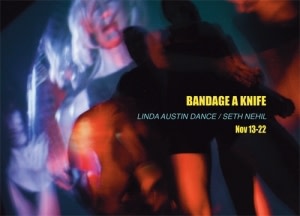Review: Bandage A Knife

There was a moment during which four of the dancers in Linda Austin and Seth Nehil’s Bandage a Knife were standing in place, slowly swinging their arms/torsos back and forth. The knees of dancer Lucy Yim trembled slightly…and I realized all of the dancers were standing, just barely, on their toes. That’s so Linda Austin, I thought, to put things just off kilter, to disorient just a little, to insert a little risk.
It’s one of Austin’s signatures to isolate a small gesture, a kind of kissy fish lips, perhaps, or hands isolated behind the back against the figure’s black shirt, lit by a flashlight. The hands signal, mark, struggle with one another. They converse with another giant pair of hands that flash on and off the video screen (flash as if caught in act). And lest one forgets Bandage is inspired by a Japanese gangster flick (it’s a "forgetting" of Seijun Suzuki’s 1967 Branded to Kill), one hears the sound of…is it knuckles cracking or breaking bone? On NPR the other day, I heard Jake Adelstein talking about Tokyo Vice, his book about the Japanese mob, the yakuza. He said the yakuza bosses were often missing fingers, that one would cut off his own finger for a mistake he made, or a mistake made by one of his underlings. Sleep with the boss’s girl? That’s a thumb.
There are fantastic moments here as when during a monologue spoken by Rebecca Harrison and mimed comically by Kaj-anne Pepper, his face is lit by Anne Furfey’s flashlight banked off a mirror held by Harrison. It starts as a straightforward narrative monologue (“I didn’t think I had it in me.”) but decays into a recitation of words that begin with the letter “b,” “butterfly, bum….” The whole passage addresses filmed reality, the act of acting, having words put in one’s mouth, and melodrama in a fairly brilliant way.
In another sequence, power relationships are flipped with Austin standing on a half-sheet of plywood on the prone Pepper’s back. Under one’s heel takes on a new meaning, or has someone been stowed under the floorboards!? This is Austin at her best, exploiting the simplest prop to powerful effect.
This amidst the general threat-level orange aggression of the choreography (whether frantically real as in self-flagellation or implied as with a foot or open palm placed on a cheek merely suggesting violence) or as aggressive as a passive demeanor can convey, made one feel as if one were swimming in choppy waters to come up for air for these interludes and be plunged under again.
The use of hand-held light sources is part of the lo-fi appeal of Austin’s work. But it’s deceptive. Her husband, Jeff Forbes, is one of Portland’s big time, go-to lighting designers. His golden footlights, his backlit corridors are not to be discounted in setting tone. The staging was interesting with black scrim-shielded corridors running the length of the space so at times, some of the figures would be illuminated there as watchers. In the third ring of the circus, on a video monitor suspended from a track stage right, a figure I initially took to be Austin (it turned out to be Pepper in a white dress) is in a white room pasting small squares on the walls at turns methodically and haphazardly.
Throughout, Nehil’s ominous score with its machinery thrum and spare use of angular stringed accents (violin strikes suggesting horror film soundtrack) held the piece sonically taut save moments of silence, spoken word, and one near the end in which dancers impassively do a low-key twist to the “boogie woogie.”
Also late in Bandage, there is a death scene to end all death scenes as the ensemble engages in an over-the-top, prolonged “Oh, I’m dying!” bit lit by a red bulb. It’s only then that one begins to read Bandage as perhaps more of a spoof than one might have thought. Were there other clues that I missed?
Performance continues through next weekend. Reservations can by had by calling 503-777-1907.
